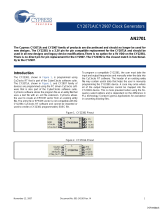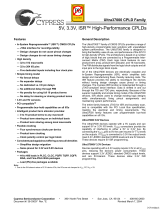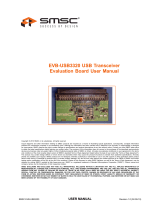Page is loading ...

DATA BRIEF
CY7C68003
MoBL-USB™ TX2UL USB 2.0
ULPI Transceiver
Cypress Semiconductor Corporation • 198 Champion Court • San Jose, CA 95134-1709 • 408-943-2600
Revised April 1, 2009
Features
The Cypress MoBL-USB
™
TX2UL is a low voltage high speed
(HS) USB 2.0 ULPI Transceiver.
The TX2UL is specifically designed for mobile handset
applications by offering tiny package options and low power
consumption.
■ USB 2.0 Full Speed and High Speed Compliant Transceiver
■ Multi-Range (1.8V to 3.3V) IO Voltages
■ Fully Compliant ULPI Link Interface
■ 8-bit SDR ULPI Data Path
■ UTMI+ Level 0 Support
■ Integrated Oscillator
■ Integrated PLL (13, 19.2, 24, or 26 MHz Reference)
■ Integrated USB Pull Up and Termination Resistors
■ 3.0V to 5.775V VBATT Input
■ Chip Select Pin
■ Single Ended Device RESET Input
■ UART Pass Through Mode
■ ESD Compliance:
❐ JESD22-A114D 8 kV Contact Human Body Model (HBM) for
DP, DM, and VSS Pins
❐ IEC61000-4-2 8 kV Contact Discharge
❐ IEC61000-4-2 15 kV Air Discharge
■ Support for Industrial Temperature Range (-40°C to 85°C)
■ Low Power Consumption for Mobile Applications:
❐ 5 uA Nominal Sleep Mode
❐ 30 mA Nominal Active HS Transfer
■ Small Package for Mobile Applications:
❐ 2.14 x 1.76 mm 20-pin WLCSP 0.4 mm Pitch
❐ 4 x 4 mm 24-pin QFN
Applications
■ Mobile Phones
■ PDAs
■ Portable Media Players (PMPs)
■ DTV Applications
■ Portable GPS Units
TX2UL
ULPI Block
XOSC
ULPI Wrapper
UTMI+
Level0
DATA[7:0]
CLOCK
DIR
STP
NXT
XI
XO
VBATT
13/19.2/
24/26 MHz
RESET_N
DP
DM
IO
Control/
Data
Logic
Operational
mode
tracking
interrupt
Tx/Rx
Core
Registers
Block
Global Control Block
Reset / Clock / Power /
Misc. Control
POR
PLL
1.8V
Bandgap
USB
FS/HS
PHY
CS_N
3.3V Regulator
Block
(3.0 –
5.775V)
VCC
(1.8V)
RXD
TXD
TX2UL Block Diagram

CY7C68003
Page 2 of 5
Functional Overview
UTMI+ Low Pin Interface (ULPI)
This block conforms to the ULPI Specification. It supports the
8-bit wide SDR data path. The primary IOs of this block support
multi-range LVCMOS signaling from 1.8V to 3.3V (±5%). The
level used is automatically selected by the voltage applied to
Vccio and is set at any voltage between 1.8V and 3.3V.
Oscillator (OSC)
This block meets the requirements of both the on-chip PLL and
the USB-IF requirements for clock parameters. It is a
fundamental mode parallel resonant oscillator with a maximum
ESR of 60 ohms. It supports the following:
■ Integrated Crystal Oscillator - 13, 19.2, 24, or 26 MHz crystal
■ 13, 19.2, 24, or 26 MHz LVCMOS single ended input clock on XI
Phase Locked Loop (PLL)
The PLL meets all clock stability requirements imposed by this
device and the USB standard. It supports all requirements to
make the device compliant to the USB 2.0 specifications. It also
has a fractional multiplier that enables it to supply the correct
frequency to the device when it is presented with a 13, 19.2, 24,
or 26 MHz reference clock.
Power On Reset (POR)
This block provides a power on reset signal (internal) based on
the input supply. An internal power on reset is generated when
VCC input rises above VPOR(trip).
Reset (RESET_N)
The three major functions of RESET_N pin are as follows:
■ Reset TX2UL
■ Place TX2UL into Sleep Mode
■ Place TX2UL into Configuration Mode
When the RESET_N pin is asserted (low) for tSTATE (tSTATE is
specified in Table 21 on page 19), the TX2UL enters into either
Sleep Mode or Configuration Mode depending on the CS_N
state. When RESET_N is asserted while CS_N is asserted,
TX2UL enters into Sleep Mode. When RESET_N is asserted for
tSTATE while CS_N is deasserted, TX2UL enters into Configu-
ration Mode. In these modes, all the pins in the ULPI interface
are tri-stated. If the RESET_N pin is not used, it must be pulled
high. For more information about different modes of configu-
ration, see Table 5 on page 4.
DP and DM pins
The DP and DM pins are the differential pins for the USB. They
must be connected to the corresponding DP and DM pins of the
USB receptacle.
Chip Select (CS_N)
This signal pin is available only in 24-pin QFN package. The two
major functions of CS_N are as follows:
■ Tri-state the ULPI bus output pins
■ Associate with RESET_N to place TX2UL in the Sleep mode
When the CS_N pin is deasserted (high), all the pins in the ULPI
interface are tri-stated.
USB2 Transceiver Macrocell Interface (UTMI+)
This block conforms to the UTMI+ Level 0 standard. It performs
all the UTMI to USB translation.
Global Control
This block is the digital control logic that ties the blocks of the
device together. Functions performed include pull up control,
over current protect control, and more.
Full Speed and High Speed USB Transceivers (FS/HS)
The FS and HS Transceivers comply fully with the USB 2.0
specifications.
USB Pull up and Intr Detect, Termination Resistors
(Pull up / TERM)
These blocks contain the USB pull up and termination resistors
as specified by the USB 2.0 specification.
UART Pass Through Mode
TX2UL supports Carkit UART Pass Through Mode. When the
Carkit Mode bit in the Interface Control register is set, it enables
the Link to communicate through the DP/DM to a remote system
using UART signaling. By default, the clock is powered down
when the TX2UL enters Carkit Mode. Entering and exiting the
Carkit Mode is identical to the Serial Mode. Table 1, Table 2, and
Figure 1 show the UART Signal Mapping between the DP/DM
and DATA[1:0] at ULPI interface.
Figure 1. UART Signal Mapping in Pass Through Mode
Table 1. UART Signal Mapping at ULPI Interface
Signal Maps to Direction Description
txd DATA[0] IN UART TXD signal
routed to DM pin
rxd DATA[1] OUT UART RXD signal
routed to DP pin
Reserved DATA[7:2] - Reserved
Table 2. UART Signal Mapping at USB Interface
Signal Maps to Direction Description
TXD DM OUT UART TXD signal
RXD DP INT UART RXD signal
TX2UL
txd
DP
DM
DATA[0]
DATA[1]
rxd
TXD
RXD
USB
INTERFACE
ULPI
INTERFACE

CY7C68003
Page 3 of 5
Clocking
TX2UL supports external crystal and clock inputs at the 13, 19.2,
24, and 26 MHz frequencies. The internal PLL applies the proper
clock multiply option depending on the input frequency. For appli-
cations that use an external clock source to drive XI, the XO pin
(in 24-pin QFN package) is left floating. TX2UL has an on-chip
oscillator circuit that uses an external 13, 19.2, 24, or 26 MHz
(±100 ppm) crystal with the following characteristics:
■ Parallel Resonant
■ Fundamental Mode
■ 750 mW Drive Level
■ 12 pF (5 percent tolerance) Load Capacitors
■ 150 ppm
TX2UL operates on one of two primary clock sources:
■ LVCMOS square wave clock input driven on the XI pin
■ Crystal generated sine wave clock on the XI and XO pins
The selection between input clock source and frequency on the
XI pin is determined by the Chip Configuration register loaded
through the RESET_N during Configuration Mode. The external
clock source requirements are shown in Figure 3 on page 4.
Figure 2. Crystal Configuration
Power Domains
The TX2UL has three power supply domains:
■ VCC
■ VIO
■ VBATT
TX2UL has two grounds:
■ VSS
■ VSSBATT
VCC
This is the core 1.8V power supply for the TX2UL. It can range
anywhere from 1.7V to 1.9V during actual operation.
VIO
This is the 1.8V to 3.3V multi range supply to the I/O ring. It can
range anywhere from 1.7V to 3.6V during actual operation.
VBATT
This is the battery input supply that powers the 3.3V Regulator
block. It can range anywhere from 3.0 to 5.775V during actual
operation.
Voltage Regulator
The internal 3.3V regulator block regulates the VBATT supply to
the internal 3.3V supply for the USBIO and XOSC blocks. If the
supply voltage at VBATT is below 3.3V, the regulator block
switches the VBATT supply directly for the USBIO and XOSC
blocks.
Power Supply Sequence
TX2UL does not require power supply sequence. All power
supplies are independently sequenced without damaging the
part. All supplies are up and stable for the device to function
properly. The analog block contains circuitry that senses the
power supply to determine when all supplies are valid.
TX2UL
XI
XO
PLL
12 pf 12 pf
XTAL
*
12 pF capacitor values assumes a trace capacitance of
3 pF per side on a four layer FR4 PCA
Table 3. External Clock Requirements
Parameter Description
Specification
Unit
Min Max
Vn Supply Voltage Noise at frequencies < 50 MHz 20 mV p-p
PN_100 Input Phase Noise at 100 Hz –75 dBc/Hz
PN_1k Input Phase Noise at 1 kHz offset –104 dBc/Hz
PN_10k Input Phase Noise at 10 kHz offset –120 dBc/Hz
PN_100k Input Phase Noise at 100 kHz offset –128 dBc/Hz
PN_1M Input Phase Noise at 1 MHz offset –130 dBc/Hz
Duty Cycle 30 70 %
Maximum Frequency Deviation 150 ppm

CY7C68003
Page 4 of 5
Operation Modes
There are six operation modes available in TX2UL. They are:
■ Normal Operation Mode
■ Configuration Mode
■ ULPI Low Power Mode
■ Sleep Mode
■ Carkit UART Pass Through Mode
■ Tri-state ULPI Interface Output Mode (only available in 24-pin
QFN package)
When changing the operation modes, if the current and changing
modes are not the Normal Operation Mode, TX2UL first changes
to the Normal Operation Mode. For example, to change from
ULPI Low power mode to Sleep mode, TX2UL changes to
Normal operation mode first, and then changes to Sleep mode.
The Mode Change State diagram in Figure 3 shows the mode
change path of TX2UL. The entries of the six operations modes
(20-pin CSP package has 5 operation modes) are listed in
Table 4 and Table 5. There are three mode change transactions
that require the RESET_N assert or deassert with tSTATE (see
Table 21 on page 19 for tSTATE). These three mode change
transactions are:
■ Change from Normal Operation Mode to Configuration Mode
– RESET_N is required to assert with tSTATE
■ Change from Configuration Mode to Normal Operation Mode
– RESET_N is required to de-assert with tSTATE
■ Change from Normal Operation Mode to Sleep Mode –
RESET_N is required to assert with tSTATE
Figure 3. Mode Change State Diagram
Normal Operation Mode
Tri-State ULPI Interface
Output Mode (available in 24-
pin QFN package only)
Sleep Mode
ULPI Low Power ModeConfiguration Mode
Carkit UART Pass Through
Mode
Table 4. TX2UL 20-Pin CPS Package Operation Modes
RESET_N Mode
0 (Low) Sleep Mode
1 (High) Normal Operation Mode
1 (High) Enter into ULPI Low Power Mode by setting Sus-
pendM register bit (in Function Control Register) to
0 during the Normal Operation Mode.
1 (High) Enter into Carkit UART Pass Through Mode by set-
ting Carkit Mode register bit (in Interface Control
Register) to 1 during the Normal Operation Mode.
0 (Low)
when
Power On
(VCC On)
Enter into Configuration Mode
Table 5. TX2UL 24-Pin QFN Package Operation Modes
CS_N RESET_N Mode
0 (Low) 0 (Low) Sleep Mode
0 (Low) 1 (High) Normal Operation Mode
0 (Low) 1 (High) Enter into ULPI Low Power Mode
by setting SuspendM register bit (in
Function Control Register) to 0 dur-
ing the Normal Operation Mode.
0 (Low) 1 (High) Enter into Carkit UART Pass
Through Mode by setting Carkit
Mode register bit (in Interface Con-
trol Register) to 1 during the Nor-
mal Operation Mode.
1 (High) 0 (Low) Configuration Mode
1 (High) 1 (High) Tri-state ULPI Interface output pins

Revised April 1, 2009 Page 5 of 5
All products and company names mentioned in this document may be the trademarks of their respective holders.
CY7C68003
© Cypress Semiconductor Corporation, 2007-2009. The information contained herein is subject to change without notice. Cypress Semiconductor Corporation assumes no responsibility for the use of
any circuitry other than circuitry embodied in a Cypress product. Nor does it convey or imply any license under patent or other rights. Cypress products are not warranted nor intended to be used for
medical, life support, life saving, critical control or safety applications, unless pursuant to an express written agreement with Cypress. Furthermore, Cypress does not authorize its products for use as
critical components in life-support systems where a malfunction or failure may reasonably be expected to result in significant injury to the user. The inclusion of Cypress products in life-support systems
application implies that the manufacturer assumes all risk of such use and in doing so indemnifies Cypress against all charges.
Any Source Code (software and/or firmware) is owned by Cypress Semiconductor Corporation (Cypress) and is protected by and subject to worldwide patent protection (United States and foreign),
United States copyright laws and international treaty provisions. Cypress hereby grants to licensee a personal, non-exclusive, non-transferable license to copy, use, modify, create derivative works of,
and compile the Cypress Source Code and derivative works for the sole purpose of creating custom software and or firmware in support of licensee product to be used only in conjunction with a Cypress
integrated circuit as specified in the applicable agreement. Any reproduction, modification, translation, compilation, or representation of this Source Code except as specified above is prohibited without
the express written permission of Cypress.
Disclaimer: CYPRESS MAKES NO WARRANTY OF ANY KIND, EXPRESS OR IMPLIED, WITH REGARD TO THIS MATERIAL, INCLUDING, BUT NOT LIMITED TO, THE IMPLIED WARRANTIES
OF MERCHANTABILITY AND FITNESS FOR A PARTICULAR PURPOSE. Cypress reserves the right to make changes without further notice to the materials described herein. Cypress does not
assume any liability arising out of the application or use of any product or circuit described herein. Cypress does not authorize its products for use as critical components in life-support systems where
a malfunction or failure may reasonably be expected to result in significant injury to the user. The inclusion of Cypress’ product in a life-support systems application implies that the manufacturer
assumes all risk of such use and in doing so indemnifies Cypress against all charges.
Use may be limited by and subject to the applicable Cypress software license agreement.
The operation and configuration modes are described in
Operation Modes on page 4 and Configuration Mode on page 14
respectively. The ULPI Low power mode and Sleep mode are
described in the following sections:
ULPI Low Power Mode
In this mode, the link optionally places the TX2UL in low power
mode when the USB is suspended. TX2UL powers down all the
circuitry except for the interface pins and full speed receiver. To
enter low power mode, the link must set SuspendM in the
Function Control register to 0b. The TX2UL clock is stopped for
a minimum of five cycles after TX2UL accepts the register write.
To exit the low power mode, the link signals TX2UL to exit the
mode by asynchronously asserting a signal, STP. The TX2UL
wakes up its internal circuitry and when it meets the ULPI timing
requirements it deasserts DIR. The SuspendM register is set to
1b.
Sleep Mode
Sleep mode is entered by asserting RESET_N during the Normal
Operation Mode. When RESET_N is driven low for tSTATE (see
Table 21 on page 19 for tSTATE requirement) while CS_N is low,
TX2UL enters into Sleep Mode. VCC must remain supplied (ON)
during the sleep mode. This mode powers down all internal
circuitry except the RESET_N pin and the chip_config register.
The ULPI interface bus is tri-stated.
During the Sleep Mode ensure that:
■ The ULPI interface IOs is either floating or driven high by the link
■ DP and DM are either floating or pull to 0V
■ Deassert RESET_N to exit the Sleep Mode.
VID and PID
The VID and PID are hard coded into Product ID and Vendor ID registers (read only) as shown in Table 6.
Table 6. Immediate Register Values for VID and PID
Field Name Size (bit)
Address (6 bits)
Value
Rd Wr Set Clr
Vendor ID (VID) Low 8 00h - - - B4h
Vendor ID (VID) High 8 01h - - - 04h
Product ID (PID) Low 8 02h - - - 03h
Product ID (PID) High 8 03h - - - 68h
/








